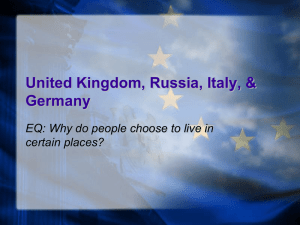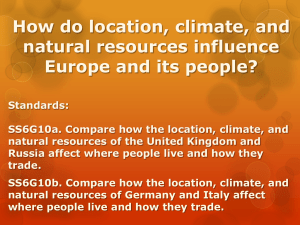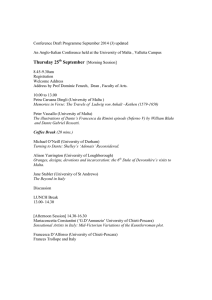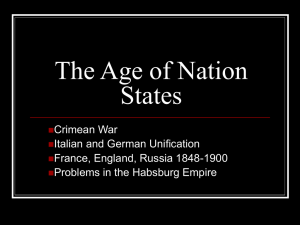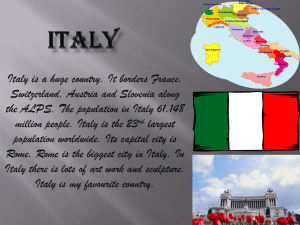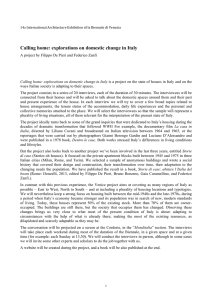Europe SS6G10 a and b - Paulding County Schools
advertisement
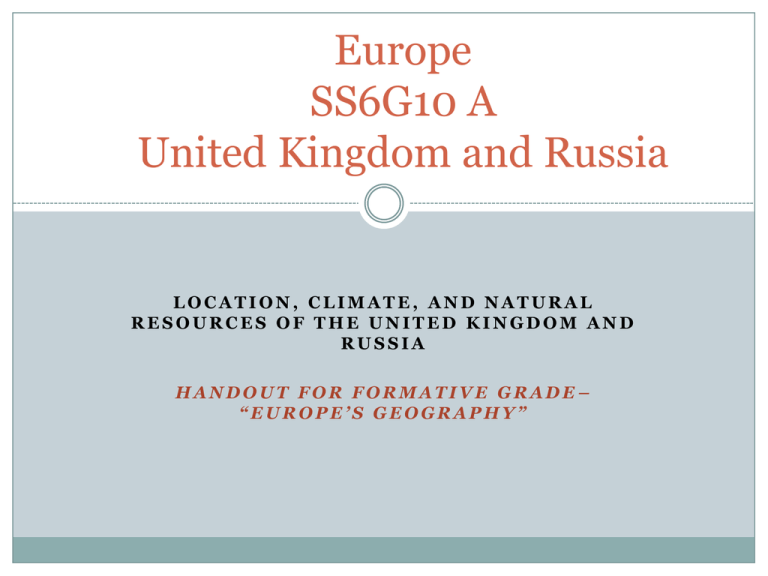
Europe SS6G10 A United Kingdom and Russia LOCATION, CLIMATE, AND NATURAL RESOURCES OF THE UNITED KINGDOM AND RUSSIA HANDOUT FOR FORMATIVE GRADE– “EUROPE’S GEOGRAPHY” After watching this video, use your best ELA skills to answer these questions in your notebook: 1. How does location effect where people live? (give specific examples) 2. How do natural resources effect where people live? (give specific examples) 3. How does climate effect where people live? (give specific examples) …continued… 4. What do the words “population density” mean? 5. What do the words “push factor” mean? (give realistic examples) 6. What do the words “pull factor” mean? (give realistic examples) Draw 2 Venn diagrams in your comp. book on 2 different pages/ sides. Label: Russia & the UK; Germany & Italy: See Anchor Charts Location of the United Kingdom The U.K. is a country of islands Great Britain Northern Ireland Scotland Wales Historically dominated world trade International trading hub -- many ports & harbors Ten major ports along the coast Location of the United Kingdom London’s Heathrow Airport (World’s Busiest Airport) Ranks 3rd In Number Of Airports In Europe International Banking & Insurance Center More Foreign Bank Branches Than Any Country In The World Atlantic Ocean Location Helps U.K. Trade With #1 Trading Partner -- USA. Climate of the United Kingdom Mild climate Mountains protect driest area, SE Great Britain keeps ports free of ice & open for trade all year Rainfall during the year – no longer than 3 weeks dry interval Non-Mountain -- mild, wet weather; seasonal temperature change Mild, wet winter – mountain snow not very deep Warmest summers in the south. The Gulf Stream winds – Gulf of Mexico Water is warm & mild causes milder winters Fertile land – good agriculture & grazing less than 2 % of population are farmers urban areas -- jobs more available Natural Resources of the United Kingdom Primary coal, petroleum, natural gas, and iron ore Other lead, zinc, gold, tin, limestone, salt, clay, chalk, gypsum, potash, sand, slate Industrial backbone auto production, steel manufacturing, and shipbuilding Losing manufacturing jobs – resources used up soon Change to cleaner forms of energy Natural Resources of the United Kingdom Mining & manufacturing retrained for service industry 80% employment tourism, health care, education, banking, insurance move to urban areas for lower wage jobs Fishing -- profitable crabs & shellfish, cod, herring, & mackerel 25% arable land, but 50%+ land is agriculture Produces approx. 60% of its own food. Location of Russia European Russia is almost landlocked Most of the land is far from the sea or frozen over for most of the year St. Petersburg Capital of Russia for 200+ years Baltic Sea port city Czars of Russia Beautiful canals, gardens & palaces Major trade center Railroad network – international shipment of goods 5 million+ people 1990’s tourism growth Location of Russia Spans 2 continents – mostly landlocked Covers eastern Europe & spans northern Asia West to East train trip would take a week Border 15 countries: China, North Korea, Finland, Norway, Poland, & Ukraine Eastern side -- bounded by the North Pacific Ocean Northern side -- bounded by the Arctic Ocean Bering Strait – closest to USA (approx. 3 miles) Climate of Russia European Russia 73% population lives here Harsh weather, but mild compared Asian Plains & Siberia climate, distance from the sea, & rugged terrain prevent use of many resources Only 2 seasons (winter & summer) July – hottest; January – coldest Annual below freezing average temp Permafrost – permanently frozen soil in many areas Winter arctic winds, harsh winters – RR changed to cross frozen lakes & rivers Climate of Russia Moscow Nation’s capital Winter – dreary -- gray skies Ground snow for 4-5 months Summer – southerly winds = warmer temperatures & little rain Asian Russia extreme climate (-40oF) but mild summers Natural Resources of Russia Vast lumber (deciduous and evergreen) forests European side mostly cleared for cities and farms. Ural Mountains: gold, aluminum ore, coal, and iron Production & exports Leading gold, minerals, metals, and machinery. process iron and other metals large mining cities Today, machinery is produced in many of the factories The Volga River 50+% major cities Industrial hydroelectric power ship manufactured goods. Country’s size & climate – difficult to use their resources For example, Siberian & Asian Russian oil and gas resources difficult to reach Comparing the United Kingdom and Russia Russia and the United Kingdom are geographically very different. By area, Russia is the larger country with a long coastline bordering the Arctic Ocean. Its port cities are locked by ice most of the year. The United Kingdom is an island country with mild climate and many ports accessible all year round. The natural resources of both countries include fossil fuels, like coal and oil. While the United kingdom’s are dwindling, much of Russia’s coal and oil is untouched because of the climate and the geography of the country. London, on the River Thames, is the capital of the United Kingdom. It is home to one of the largest financial centers in the world. International stocks are traded on the London Stock Exchange, and many foreign banks have branches there. Moscow, the capital of Russia, is its larges city. Moscow is the center for all transportation with Russia, but it is St. Petersburg, on the Baltic Sea, that is the Russian center for trade. Europe SS6G10 B Germany and Italy LOCATION, CLIMATE, AND NATURAL RESOURCES OF GERMANY AND ITALY Location of Germany Germany is located in north-central Europe on the European Plain. Germany is about the size of South Carolina, Georgia, and Alabama combined. However, five times more people live in Germany than in these three states. Germany is one of the most densely populated parts of Europe. About 85 percent of people live in urban areas. The land is generally in three zones. Alps Mountains in the south, hilly to mountainous in the middle, plains in the north. The Rhine River, much of which lies in Germany, is very important for trade. This river is over eight hundred miles long. The Rhine begins in the Alps and flows north, through Germany to the North Sea. Many German cities lie along the Rhine. This location gives those cities an excellent way to transport goods and people. Germany’s location in the center of Europe make it a crossroads of travel and trade. The country’s excellent highway system has helped Germany take advantage of its location. Countries from Eastern Europe and Western Europe transport goods to and across Germany. Germany has built many highways, bridges, and tunnels to improve trade with countries to the south. Germany has eight major ports, which handle the country’s exports and imports. Fourteen major airports transport good and people all over the world Climate of Germany Most of Germany has a marine climate. The waters of the Gulf Stream warm the region. That means that the warm waters of the ocean help to keep the land warm in winter. The sea also cools the land in summer. The ocean also brings moisture to the land. Precipitation provides enough moisture for the land to produce good crops. Eastern Germany is farther from the effects of the sea. This part of the country has longer, colder winters. Summers tend to be longer, hotter and drier. Natural Resources of Germany Germany has many nature resources. Iron ore, coal ,and potash are major products from mining Uranium, which is used for nuclear fuel, is found in Germany. Nickel, natural gas, and copper are important too. Timber is a renewable resource. Much of the forest in the north has been cut to provide land for farms, villages, and towns, but there are still large amounts of timber in the south. About one-third of the land is arable. Natural resources such as coal helped to build large industrial areas. These areas became large cities in Germany. Many of these are along the Rhine River. Location of Italy Italy is a country in southern Europe. It is on a long, boot shaped peninsula. The peninsula is surrounded on three sides by the Mediterranean Sea. The northern border of Italy is in the Alps. Italy is about twice the size of the state of Georgia, but it has seven times as many people. Seven out of ten people in Italy live in urban areas. The largest urban areas are Rome, Naples, Milan and Turin. About half of the people in Italy live in the most northern one third of the country. Islands and mountains affect life in Italy. The mountains affect where people live and how they transport goods and people. Italy’s location on the Mediterranean Sea affects trade with other countries. Italy has a long history of shopping goods to and from other countries in Europe and Asia. Merchants took advantage of Italy's location to trade goods from Africa, Asia Europe. Today there are seven major airports and about one hundred smaller one. Eight major seaports can handle the larges ships pm the sea/ Excellent highways, bridges, and tunnel connect Italy with their neighbors to the north Climate of Italy Most of Italy has a Mediterranean climate. The Mediterranean Sea surrounding Italy keeps the temperature comfortable most of the year. Summer skies are generally clear, and rain is rare in the summer. Dry summers are one of the main characteristics of this climate. Winters are usually cloudy and rainy. Not all of Italy has the same kind of climate. The mountains have a climate that changes with altitude. The temperature is usually cooler than the temperature in lower elevations. The south is drier than the north. Northern Italy has enough rain for growing crops. Southern Italy is much drier. It only gets about half as much rain as northern Italy. Natural Resources of Italy Italy has few mineral resources. Natural gas is the most valuable mineral resource found in Italy. It is used to help supply the country’s energy needs. Marble and granite are available. These are used in the construction of buildings and artwork. Coal, mercury, zinc, and potash are other minerals found in Italy. Arable land is important in Italy. Small farms cover much of the country. Grapes and olives are important crops. Italy is one of the world’s top wine-making countries because of its excellent grape crop. The sea is an important resource, too. The long coastline allows for more than eight hundred ports for fishing boats. About 50,000 Italians make their living as fisherman. Anchovies and sardines are two fish important to the economy.
